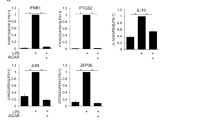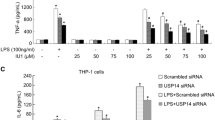Abstract
An ADP ribosylation factor-GTPase activating protein (ASAP1) is highly expressed in a variety of tumor cells and is involved in the cell motility, invasion, and metastasis. In order to elucidate the involvement of ASAP1 in lipopolysaccharide (LPS)-mediated inflammatory response, the effect of ASAP1 silencing on LPS-induced proinflammatory mediators production was examined by using RAW 264.7 macrophage-like cells. ASAP1 was constitutively expressed in the cells and the expression was augmented by LPS stimulation. Silencing of ASAP1 with small interfering RNA enhanced the production of tumor necrosis factor-α, interleukin 6, interferon-β, and nitric oxide in response to LPS. ASAP1 silencing augmented the activation of nuclear factor (NF)-κB and several mitogen-activated protein kinases (MAPKs). On the other hand, ASAP1 silencing did not affect the expression of IRAK4, TRAF6, and Akt as the upstream molecules of NF-κB signaling. A series of toll-like receptor ligands as well as LPS augmented the ASAP1 expression. Taken together, ASAP1 was suggested to negatively regulate LPS-induced proinflammatory mediators production through down-regulating LPS signaling. The feedback function of ASAP1 in LPS-mediated inflammatory response is discussed.






Similar content being viewed by others
Abbreviations
- ASAP1:
-
ADP ribosylation factor (Arf)-GTPase activating protein
- ERK1/2:
-
Extracellular signal-regulated kinase 1/2
- ELISA:
-
Enzyme-linked immunosorbent assay
- GAPDH:
-
Glyceraldehyde 3-phosphate dehydrogenase
- IFN-β:
-
Interferon-β
- IKK:
-
IκB kinase
- IRAK4:
-
Interleukin-1 receptor-associated kinase-4
- JNK:
-
c-Jun N-terminal kinase
- LPS:
-
Lipopolysaccharide
- MAPK:
-
Mitogen-activated protein kinase
- MyD88:
-
Myeloid differentiation factor 88
- NF-κB:
-
Nuclear factor-κB
- NO:
-
Nitric oxide
- RT–PCR:
-
Reverse transcription-polymerase chain reaction
- SAPK:
-
Stress-activated protein kinase
- siRNA:
-
Small interfering RNA
- TLR:
-
Toll-like receptor
- TNF-α:
-
Tumor necrosis factor-α
- TRAF6:
-
TNF receptor-associated factor 6
References
Jian X, Brown P, Schuck P, Gruschus JM, Balbo A, Hinshaw JE, Randazzo PA (2009) Autoinhibition of Arf GTPase-activating protein activity by the BAR domain in ASAP1. J Biol Chem 284:1652–1663
Linder S (2007) The matrix corroded: podosomes and invadopodia in extracellular matrix degradation. Trends Cell Biol 17:107–117
Linder S, Aepfelbacher M (2003) Podosomes: adhesion hotspots of invasive cells. Trends Cell Biol 13:376–385
Randazzo PA, Andrade J, Miura K, Brown MT, Long YQ, Stauffer S, Roller P, Cooper JA (2000) The Arf GTPase-activating protein ASAP1 regulates the actin cytoskeleton. Proc Natl Acad Sci USA 97:4011–4016
Liu Y, Yerushalmi GM, Grigera PR, Parsons JT (2005) Mislocalization or reduced expression of Arf GTPase-activating protein ASAP1 inhibits cell spreading and migration by influencing Arf1 GTPase cycling. J Biol Chem 280:8884–8892
Muller T, Stein U, Poletti A, Garzia L, Rothley M, Plaumann D, Thiele W, Bauer M, Galasso A, Schlag P, Pankratz M, Zollo M, Sleeman JP (2010) ASAP1 promotes tumor cell motility and invasiveness, stimulates metastasis formation in vivo, and correlates with poor survival in colorectal cancer patients. Oncogene 29:2393–2403
Kawai T, Akira S (2005) Toll-like receptor downstream signaling. Arthritis Res ther 7:12–19
Kawai T, Akira S (2007) Signaling to NF-kappaB by Toll-like receptors. Trends Mol Med 13:460–469
Noman AS, Koide N, Iftakhar-E-Khuda I, Dagvadorj J, Tumurkhuu G, Naiki Y, Komatsu T, Yoshida T, Yokochi T (2010) Retinoblastoma protein-interacting zinc finger 1, a tumor suppressor, augments lipopolysaccharide-induced proinflammatory cytokine production via enhancing nuclear factor-κB activation. Cell Immunol 264:114–118
Khuda II, Koide N, Noman AS, Dagvadorj J, Tumurkhuu G, Naiki Y, Komatsu T, Yoshida T, Yokochi T (2009) Astrocyte elevated gene-1 (AEG-1) is induced by lipopolysaccharide as toll-like receptor 4 (TLR4) ligand and regulates TLR4 signalling. Immunology 128:700–706
Green LC, Wagner DA, Glogowski J, Skipper PL, Wishnok JS, Tannenbaum SR (1982) Analysis of nitrate, nitrite, and [15N] nitrate in biological fluids. Anal Biochem 126:131–138
Haque A, Koide N, Iftakhar-E-Khuda I, Noman AS, Odkhuu E, Badamtseren B, Naiki Y, Komatsu T, Yoshida T, Yokochi T (2011) Flavopiridol inhibits lipopolysaccharide-induced tumor necrosis factor-α production through inactivation of nuclear factor-κB and mitogen-activated protein kinases in the MyD88-dependent pathway. Microbiol Immunol 55:160–167
Hassan F, Islam S, Tumurkhuu G, Naiki Y, Koide N, Mori I, Yoshida T, Yokochi T (2006) Intracellular expression of toll-like receptor 4 in neuroblastoma cells and their unresponsiveness to lipopolysaccharide. BMC Cancer 8:281–288
Saklatvala J, Davis W, Guesdon F (1996) Interleukin 1 (IL1) and tumour necrosis factor (TNF) signal transduction. Philos Trans R Soc Lond B Biol Sci 351:151–157
Han J, Lee JD, Bibbs L, Ulevitch RJ (1994) A MAP kinase targeted by endotoxin and hyperosmolarity in mammalian cells. Science 265:808–811
Hambleton J, Weinstein SL, Lem L, DeFranco AL (1996) Activation of c-Jun N-terminal kinase in bacterial lipopolysaccharide-stimulated macrophages. Proc Natl Acad Sci USA 93:2774–2778
Suzuki N, Saito T (2006) IRAK-4—a shared NF-κB activator in innate and acquired immunity. Trends Immunol 27:566–572
Romashkova JA, Makarov SS (1999) NF-kappaB is a target of AKT in anti-apoptotic PDGF signalling. Nature 401:86–90
O’Neill LA, Bowie AG (2007) The family of five: TIR-domaincontaining adaptors in Toll-like receptor signaling. Nat Rev Immunol 7:353–364
Kamijo R, Harada H, Matsuyama T et al (1994) Requirement for transcription factor IRF-1 in NO synthase induction in macrophages. Science 263:1612–1615
Perrella MA, Patterson C, Tan L, Yet SF, Hsieh CM, Yoshizumi M, Lee ME (1996) Suppression of interleukin-1beta-induced nitric-oxide synthase promoter/enhancer activity by transforming growth factor-beta1 in vascular smooth muscle cells. Evidence for mechanisms other than NF-kappaB. J Biol Chem 271:13776–13780
Chaturvedi MM, Sung B, Yadav VR, Kannappan R, Aggarwal BB (2011) NF-κB addiction and its role in cancer: ‘one size does not fit all’. Oncogene 30:1615–1630
Staudt LM (2010) Oncogenic activation of NF-κB. Cold Spring Harb Perspect Biol 2:1–30
Miyata M, Raven JF, Baltzis D, Koromilas AE, Sabe H (2008) IRES-mediated translational control of AMAP1 expression during differentiation of monocyte U937 cells. Cell Cycle 7:3273–3281
Acknowledgments
This work was supported by in part by a Grant-in-Aid for Scientific Research from the Ministry of Education, Science, Sports and Culture of Japan. We are grateful to K. Takahashi and A. Morikawa for the technical assistance.
Conflict of interest
The authors report no conflicts of interest. The authors alone are responsible for the content and writing of the paper.
Author information
Authors and Affiliations
Corresponding author
Rights and permissions
About this article
Cite this article
Haque, A., Noman, A.S.M., Koide, N. et al. An ADP ribosylation factor-GTPase activating protein negatively regulates the production of proinflammatory mediators in response to lipopolysaccharide. Cancer Immunol Immunother 60, 1439–1446 (2011). https://doi.org/10.1007/s00262-011-1048-9
Received:
Accepted:
Published:
Issue Date:
DOI: https://doi.org/10.1007/s00262-011-1048-9




